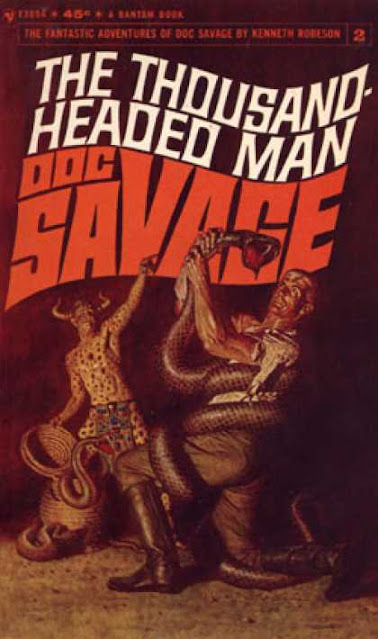When Last We Left Our Hero...
Things look tight for He Who Knows What Evil Lurks in the Heart of Shiwan Khan, doesn't it?And, where the hell is his slouch hat...or his nose?
Read thru to the end and find out, kiddo!
As you can see, there were quite a few changes between The Shadow's last comic appearance in his own Street & Smith book in 1949, and this premiere presentation in 1964.
In effect, they rebooted the character and "updated" him to the swinging spy-oriented '60s.
The Batman tv series had not yet debuted, so the "creators" were using the James Bond films and Marvel Comics as their template.
The script was by Robert Bernstein, a writer who had penned stories for almost every publisher including DC, Atlas, and EC. The Shadow was his last comics work.
Pencils and inks were by John Rosenberger, who had started out doing horror at American Comics Group, then moved to Archie where he did The Fly, The Jaguar, and Young Doctor Masters, a clone of the then-popular Dr Kildare tv series. (In fact, Lamont Cranston, without glasses, is a dead ringer for Dr Masters!). Eventutally, he ended up at DC, where he did romance comics as well as Supergirl, Lois Lane, and Wonder Woman (usually inked by Vince Colletta).
How did Archie end up doing The Shadow?
They acquired the comic rights thru a sister company, Belmont Books, which was doing a series of new Shadow novels.
The first one, Return of The Shadow, written by the pulp Shadow's creator Walter Gibson, kept to the concept and style of the original pulp run.
It was meant to be a lead-in to a line of pulp reprints.
However, it sold well enough that the publisher decided to go with all-new stories, but "updated" with "modern" story elements.
Gibson wasn't interested in going that route, so Dennis Lynds assumed the Maxwell Grant byline for an additional eight novels which combined the pulp and radio versions along with superspies.
The paperbacks did retain the cloaked and slouch-hatted imagery on the covers, which can be found on our brother blog, Atomic Kommie Comics.
(Ironically, both Lynds and Gibson later contributed stories to the same spy series: The Man from U.N.C.L.E.! Lynds wrote a number of novelettes for the tv show's digest magazine, and Gibson wrote a juvenile novel, "The Coin of El Diablo Affair".)
The first two issues of Archie's Shadow follow, somewhat, the revamped Belmont Books version.
Curiously, The Shadow does appear in full cloak and hat (and nose) on the cover to #1...
...but that version never appears again during the series eight-issue run.
In fact, as of #2, there are further alterations afoot!
But that's a story for another time...
for goodies featuring other Silver Age heroes, besides The Shadow!
And check out the Shadow goodies from Amazon below...











